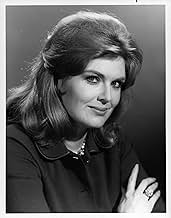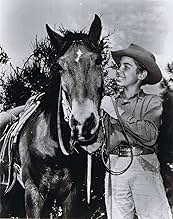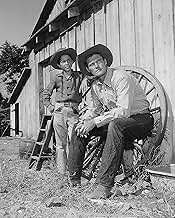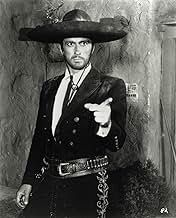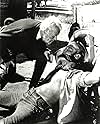Les aventures d'un éleveur du Far West et de son fils, maniant un fusil Winchester à tir rapide personnalisé.Les aventures d'un éleveur du Far West et de son fils, maniant un fusil Winchester à tir rapide personnalisé.Les aventures d'un éleveur du Far West et de son fils, maniant un fusil Winchester à tir rapide personnalisé.
- Nommé pour 2 prix Primetime Emmy
- 3 nominations au total
Parcourir les épisodes
Avis en vedette
I watched this show every week as a kid - I'm 56. I liked it a lot but being around 10 I don't think I really appreciated all it had to offer. Compared to what's on TV these days (I know this makes me sound old. OK, point taken.) the writing was very good. The interplay between Lucas & Mark was genuine; I understand they were fast friends until Connors' death. The only thing I didn't understand was why North Fork even needed a sheriff; Lucas bailed Micah out nearly every week. Oh, well....
It's running on Encore right now. I'm just glad to see that somebody in authority has realized that these old shows shouldn't be dismissed just because they were filmed in black & white. It's the quality of the product that matters. I'm hoping to see Have Gun Will Travel, The Life & Legend of Wyatt Earp, The Rebel, and other shows of this era soon too.
It's running on Encore right now. I'm just glad to see that somebody in authority has realized that these old shows shouldn't be dismissed just because they were filmed in black & white. It's the quality of the product that matters. I'm hoping to see Have Gun Will Travel, The Life & Legend of Wyatt Earp, The Rebel, and other shows of this era soon too.
I think much of the success of "The Rifleman" TV series was due to the casting of Chuck Connors as the "hero." We quickly grew used to him in this part but at the time the series started, he was probably regarded by many casting directors as a "bad guy" -- such as the part he played in "The Big Country." There was something mean and menacing about him. But by casting him as the boy's father in "The Rifleman," the show used Connors' toughness to counteract the sentimentality that might otherwise have enveloped this series. (Can you imagine how syrupy "The Rifleman" would have been had Doug McClure played the lead?)
I don't know why they used a colorized photo to represent The Rifleman show on the video cover. If the video is colorized, that would be a good reason to not buy it. And I'm not particularly against colorized reprints. It's just that this show truly shined in its B&W mode.
As was demonstrated by Frankenheimer's The Train, a few cinematographers and directors reached a peak of artistic visual clarity during the late 50s-early 60s. This TV show was a good example of that artisanship. Such quality continues to be rare in TV production. You could say it's because TV production has always been a low-funded affair, but such fine art doesn't cost any more than the expensive stuff. What it takes is a highly talented cinematographer and director. That's the rarity, in both films and TV.
Viewers were certainly not jaded back then, nonetheless when a show aired on TV that was clearly well produced, in terms of b&w visual clarity, you can bet we uneducated viewers noticed it, if we weren't yet aware of why we were noticing it. The Rifleman was that kind of show. The screen of our old Zenith b&w console, not a high tech unit by any means, really lit up when this show came on. Like a musician who can take a shabby instrument and make it sing, this quality of production could somehow make our crummy old TV look better than it was worth. A real value, for free and on the air.
The opening sequence to every episode was exciting enough to suck any of us into the TV screen, with the camera dollying backwards in sinc with Connors moving forward repeatedly shooting/cocking his modified, cut-down rifle. No music yet. Nothing but bam, bam, bam, bam, bam, bam, bam, bam `The Rifleman' the seriously over-concerned voice-over would announce. We were hooked, and the western styled orchestral music would begin to play.
What is most striking as I vividly remember this shot now almost 40 years later, is the utter smoothness of Connor's walk and steady gaze as he moved forward step by slow step. I realize it is the exact same style of strong, silent type walk which Clint Eastwood was making a trademark. Funny to think that Connors, not a highly respected actor in circles, was doing this bit just as well as Eastwood did so many times later. Hey, if it works, work it. They had similar body types, and their plain, button-down western shirts fit in the same way. These were not the heavily muscled heroes today's boys are led to appreciate. They were tall, sinewy men, and it leant their characters a certain degree of intelligence along with the brawn.
Westerns were such a solid part of Hollywood movie studios' profit revenue, that's why artistic license was allowed the directors of these independently produced film/TV productions. Leave It to Beaver, believe it or not, was another great example of intelligent writing allowed into a stagnant arena of suburban styled family serials. Just check out the difference between Beaver and Dobie Gillis, as compared to Ozzie and Harriet and Gilligan's Island. The latter were undeniably stupid, one dimensional shows, while the former brought intelligent satire into play.
As I look back, a fatherless child at the time, Connors' brave good guy/bad guy characters really worked on me. This was where I managed to develop a diverse sense of humanity, because the directors and writers were allowed to make these characters and their stories somewhat multi-dimensional. The 60s was a great time, in terms of expanding a very innocent TV audience's view of the world outside our sheltered lives (there was never anything closely resembling CNN or Howard Stern, of course).
Two years after The Rifleman finished running there started a new Chuck Connors cowboy series called Branded. Where The Rifleman was certainly the most violently provocative show on TV, Branded was even more sadistic. As kids we ate it all up. In what is now understood to be a sort of Peckinpah tradition of graphic violence, these shows were the directors' training grounds for such sadistic style. They were really pushing the envelope of censorship. My mom used to get upset when we watched these shows.
As was demonstrated by Frankenheimer's The Train, a few cinematographers and directors reached a peak of artistic visual clarity during the late 50s-early 60s. This TV show was a good example of that artisanship. Such quality continues to be rare in TV production. You could say it's because TV production has always been a low-funded affair, but such fine art doesn't cost any more than the expensive stuff. What it takes is a highly talented cinematographer and director. That's the rarity, in both films and TV.
Viewers were certainly not jaded back then, nonetheless when a show aired on TV that was clearly well produced, in terms of b&w visual clarity, you can bet we uneducated viewers noticed it, if we weren't yet aware of why we were noticing it. The Rifleman was that kind of show. The screen of our old Zenith b&w console, not a high tech unit by any means, really lit up when this show came on. Like a musician who can take a shabby instrument and make it sing, this quality of production could somehow make our crummy old TV look better than it was worth. A real value, for free and on the air.
The opening sequence to every episode was exciting enough to suck any of us into the TV screen, with the camera dollying backwards in sinc with Connors moving forward repeatedly shooting/cocking his modified, cut-down rifle. No music yet. Nothing but bam, bam, bam, bam, bam, bam, bam, bam `The Rifleman' the seriously over-concerned voice-over would announce. We were hooked, and the western styled orchestral music would begin to play.
What is most striking as I vividly remember this shot now almost 40 years later, is the utter smoothness of Connor's walk and steady gaze as he moved forward step by slow step. I realize it is the exact same style of strong, silent type walk which Clint Eastwood was making a trademark. Funny to think that Connors, not a highly respected actor in circles, was doing this bit just as well as Eastwood did so many times later. Hey, if it works, work it. They had similar body types, and their plain, button-down western shirts fit in the same way. These were not the heavily muscled heroes today's boys are led to appreciate. They were tall, sinewy men, and it leant their characters a certain degree of intelligence along with the brawn.
Westerns were such a solid part of Hollywood movie studios' profit revenue, that's why artistic license was allowed the directors of these independently produced film/TV productions. Leave It to Beaver, believe it or not, was another great example of intelligent writing allowed into a stagnant arena of suburban styled family serials. Just check out the difference between Beaver and Dobie Gillis, as compared to Ozzie and Harriet and Gilligan's Island. The latter were undeniably stupid, one dimensional shows, while the former brought intelligent satire into play.
As I look back, a fatherless child at the time, Connors' brave good guy/bad guy characters really worked on me. This was where I managed to develop a diverse sense of humanity, because the directors and writers were allowed to make these characters and their stories somewhat multi-dimensional. The 60s was a great time, in terms of expanding a very innocent TV audience's view of the world outside our sheltered lives (there was never anything closely resembling CNN or Howard Stern, of course).
Two years after The Rifleman finished running there started a new Chuck Connors cowboy series called Branded. Where The Rifleman was certainly the most violently provocative show on TV, Branded was even more sadistic. As kids we ate it all up. In what is now understood to be a sort of Peckinpah tradition of graphic violence, these shows were the directors' training grounds for such sadistic style. They were really pushing the envelope of censorship. My mom used to get upset when we watched these shows.
I loved the opening to the Rifleman. It starts out with Chuck Connors firing off a salvo from that cool looking Winchester slung down low. Man, he meant business. And then the theme song began. I just had to watch it. I saw many episodes in reruns, when I was about 10 or 11, in the middle 60's , usually on Saturday or Sunday afternoon. The original was a little before my time. It was really my kind of show. Great cast. Luke was great. (Ah Paaaah!)Chuck Connors was awesome! And you knew that at some point in the show he was going to have to use that awesome rifle. I still remember the episode where he had a big fist fight and got a fat lip and winced and then chuckled while taking a sip of coffee to end the show. That was back in the day when Westerns were king.
After some people thought that Chuck Conners as the "bad guy" in such films as "The Big Country",it was quickly misjudged by his character when he played Lucas McCain in "The Rifleman". The show was centered around him and his son Mark in the town of Northfolk. But the coolest thing on that show was that Winchester rifle he had,and he could fire at any range from it!!! He never used a six shooter. The way he took on the baddies with that rifle was the absolute trademark of that show which was one of the coolest and most exciting TV westerns ever to come out of the 1950's,and to this day it still holds up to other TV westerns that would endure years later. A great classic from that golden age of grand TV.
Le saviez-vous
- AnecdotesIn the pilot, originally written for Le justicier (1955), Chuck Connors' character was named John McCain, he had no children and he was a dead shot with a pistol. Arnold Laven decided to make McCain a widower with a son whose weapon of choice was a customized Winchester rifle.
- GaffesLucas McCain's rifle is a modified 1892 .44-40 Winchester, even though the series clearly establishes itself in the 1880s.
- Citations
[repeated line]
Mark McCain: Pa!
- ConnexionsFeatured in The Movie Orgy (1968)
Meilleurs choix
Connectez-vous pour évaluer et surveiller les recommandations personnalisées
- How many seasons does The Rifleman have?Propulsé par Alexa
Détails
- Date de sortie
- Pays d’origine
- Site officiel
- Langue
- Aussi connu sous le nom de
- Westlich von Santa Fe
- Lieux de tournage
- sociétés de production
- Consultez plus de crédits d'entreprise sur IMDbPro
- Durée30 minutes
- Couleur
- Rapport de forme
- 4:3
Contribuer à cette page
Suggérer une modification ou ajouter du contenu manquant



